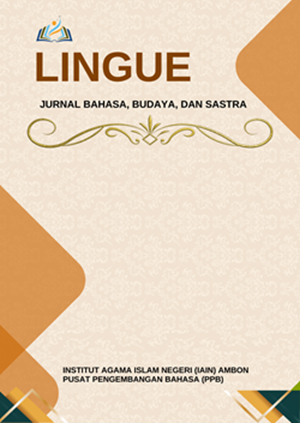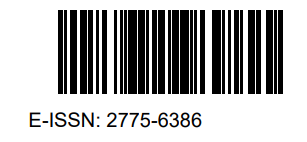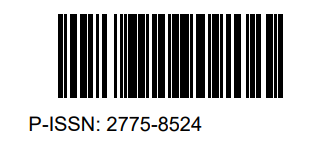ANALYSIS OF INDONESIAN LANGUAGE USAGE ON SIGNBOARDS TOURIST ATTRACTIONS AND ROADS IN CENTRAL MALUKU REGENCY
DOI:
https://doi.org/10.33477/lingue.v7i1.9352Keywords:
central maluku, indonesian language, tourism objectsAbstract
The use of proper and correct Indonesian on public signage reflects professionalism and the image of a region in the eyes of tourists and the general public. This study aims to analyze the use of Indonesian on tourism signage and street signs in Central Maluku Regency. This research uses a qualitative method with a phenomenological approach to reveal the reality of Indonesian language usage in public spaces. The findings of this study include two main results. First, the portrayal of Indonesian usage on tourism signage and street signs in the areas of Tulehu, Waai, Liang, and Morella, which contains 16 data points (10 tourism signage data and 6 street sign data). These are only three tourism signs (in Tulehu, Liang, and Morella) adhered to normative theory, while the rest did not, especially those in Wai, Liang, Tulehu, and Morella. Second, there are four areas where the signs align with communicative theory (Tulehu, Waai, Liang); however, two data points in Tulehu and Morella do not align due to incorrect writing on street signs, which causes confusion among road users. This study makes a significant contribution to the development of language policy, particularly in organizing Indonesian language in public spaces in Central Maluku Regency. The results can serve as a reference for local governments, tourism destination managers, and the public to raise awareness and skills in using proper and correct Indonesian, thus creating a positive regional image and facilitating public communication
References
Abdurrahman, F. (2023). Perubahan Lafal Baku Dalam Bahasa Indonesia Akibat Dialek Daerah. Jurnal Bahasa, Sastra, dan Budaya. 13(3), 47—53. https://doi.org/10.37905/jbsb.v13i3.19837.
Alwasilah, A. C. (2017). Filsafat bahasa dan pendidikan. PT Remaja Rosdakarya. Arditama, E. (2016). Mengkaji Ruang Publik dari Perspektif Kuasa: Fenomena
Kemenangan Aktor Hegemonik Melalui Dominasi Budaya. Politik Indonesia: Indonesian Political Science Review, 1(1), 69–86. 10.15294/jpi.v1i1.9181.
Backhaus, P. (2007). Linguistic landscapes: A comparative study of urban multilingualism in Tokyo. Clevedon: Multilingual Matters.
Barges, F. A., dkk. (2025). Kajian Potensi Wisata Berbasis Kearifan Lokal di Negeri Waai Kecamatan Salahutu Kabupaten Maluku Tengah. Jurnal Sylva Scienteae, 8(1), 88-101. https://doi.org/10.20527/jss.v8i1.13160
Berg, B L, 2001. Qualitative Research Methods for The Social Sciences Fourth
Edition. Allyn And Bacon: USA
Blommaert, Jan. (2013). Ethnography, Superdiversity and Linguistic Landscapes: Chronicles of Complexity. Ontario: Multilingual Matters.
Chaer, A. (2015). Sosiolinguistik: Perkenalan awal. Rineka Cipta.
Candrawinata, I. 2014). Penggunaan Bahasa pada Papan Nama Toko di Malioboro. Skripsi: Fakultas Bahasa dan Seni Universitas Negeri Yogyakarta
Devinty, R. (2021). Penggunaan Kata Baku dan Tidak Baku dalam Bahasa Indonesia.
Jurnal Pendidikan Bahasa Indonesia, 1(2), 121-132. http://dx.doi.org/10.30821/eunoia.v1i2.1136
Dokolamo, H. (2020). Matarumah Parentah dalam Sistem Pemerintahan Adat di Maluku. Jurnal Lani: Kajian Ilmu Sejarah & Budaya, 1(1), 27-36.
Erikha, F. (2018). Konsep Lanskap Linguistik pada Papan Nama Jalan Kerajaan (Râjamârga): Studi Kasus Kota Yogyakarta. Jurnal Kajian Budaya, 8(1), https://doi.org/10.17510/paradigma.v8i1.231
Firmansyah, et.al. (2021). Esensi Perbedaan Metode Kualitatif dan Kuantitatif. Jurnal Ekonommi Pembangunan, 3(2), 156-159.
Nanda Saputra, et.al. (2020). Teori dan Aplikasi Bahasa Indonesia. Penerbit : CV Kekata Group. Anggota Ikapi: Surakarta
Hasan, N. H. (2020). Penggunaan Bahasa Indonesia pada Papan Nama Toko, Perumahan, dan Hotel Di Kota Ambon. Jurnal Totobuan, 8(2), 283—295.
Gorter, D. (Ed.). (2013). Linguistic landscape: Expanding the scenery. New York: Routledge.
Hardiman, F. B. (2009). Menuju Masyarakat Komunikatif. Yogyakarta: Penerbit Kanisius.
Hilaliyah, H., et.al. (2024). Taksonomi Fungsi Lanskap Linguistik Taman Ayodia dan Taman Puring Jakarta Selatan. Ranah: Jurnal Kajian Bahasa, 13(1), 71—
88. https://doi.org/10.26499/rnh.v13i1.7063
Hendrastuti, R. (2015). Variasi Penggunaan Bahasa pada Ruang Publik Kota Surakarta. Kandai, 11(1), 32–33.
Joseph, dkk. (2020). Perencanaan Master Plan Kawasan Objek Wisata Pantai Kuako Kecamatan Amahai Kabupaten Maluku Tengah. Jurnal Manumata, 6(2), 53–61, https://doi.org/10.51135/manumatav6i2p53-61
Laksmi, E. D. (2018). Perencanaan bahasa dan kebijakan bahasa daerah: Partisipasi masyarakat dalam pelestarian bahasa. Jurnal Pendidikan Bahasa dan Sastra Indonesia, 7(2), 102–113.
Latukau, S., et.al. (2024). Daya Dukung Fisik dan Persepsi Pengunjung Pantai Lubang Buaya di Negeri Morella Kecamatan Leihitu Kabupaten Maluku Tengah. Marsegu: Jurnal Sains dan Teknologi, 1(3),265-278. https://doi.org/10.21107/metalingua.v3i2.7040
Lewenussa, R. A., dkk. (2023). The Relationship Between the Habits of Playing Football with the Achievement Trends of Football Players in Negeri Tulehu, Salahutu Sub-District. Jurnal Ilmiah Wahana Pendidikan, 9(12), 722- 732.
Muslich, M. (2010). Tata bahasa Indonesia kontemporer. Bumi Aksara.
Nurlaili, S. (2019). Lanskap linguistik kota metropolitan: Analisis penggunaan bahasa pada papan nama di Jakarta Selatan. Jurnal Linguistik Terapan, 9(1), 45–57.
Puzey, G. 2016. Renaming as Counter-Hegemony: The Cases of Noreg and Padania. Dalam Names and Naming: People, Places, Perceptions, and Power, ed. Guy Puzey dan Laura Kostanski, 244–272. Bristol: Multilingual Matters.
Setyowati, N. (2021). Bahasa dan pariwisata: Representasi identitas lokal dalam lanskap linguistik Bali. Jurnal Bahasa dan Sastra, 22(1), 25–38.
Setyowati, Y. (2016). Tindakan Komunikatif Masyarakat “Kampung Preman” dalam Proses Pemberdayaan. Jurnal Aspikom, 3(1), 16–32. https://10.24329/aspikom.v3i1.96.
Shohamy, E. (2006). Language policy: Hidden agendas and new approaches. New York: Routledge.
Soplero, E., et.al. (2024). Rencana Pengembangan Kawasan Mangrove Negeri Waai menjadi Objek Ekowisata Berbasis Mitigasi Bencana. Papalele: Jurnal Penelitian Sosial Ekonomi Perikanan dan Kelautan, 8(2), 213-225. 10.30598/papalele.2024.8.2.213
Spolsky, B. (2009). Language management. Cambridge: Cambridge University Press. Pieris, John (2004). Tragedi Maluku: Sebuah Krisis Peradaban, Analisis Kritis Aspek: Politik, Ekonomi, Sosial-Budaya, dan Keamanan. Jakarta: Yayasan
Obor Indonesia.
Terlir, C. (2022). Struktur Komunitas Mangrove di Perairan Panta Waai Kecamatan Salahutu Kabupaten Maluku Tengah. Skripsi. Fakultas Ilmu Kelautan dan Perikanan: Universitas Pattimura Ambon.
Tuasela, S., et.al. (2025). Pengembangan Kawasan Wisata Buatan Rumah Pohon Berbasis Ekowisata di Negeri Waai, Kecamatan Salahutu. Jupeis: Jurnal Penndidikan dan Ilmu Sosial, 4(1),
Tuasikal, T. (2021). Evaluasi Pengembangan Ekowisata Pantai Batu Kuda di Desa Tulehu Kecamatan Salahutu Kabupaten Maluku Tengah. Journal of Science and Technology, 2(1), 78–89 10.51135/justevol2issue1page78-89.
Waelauruw, A.T. (2023). Tinjauan Potensi Wisata pada Pantai Hunimua, Desa Liang, Kecamatan Salahutu, Kabupaten Maluku Tengah. Jurnal Administrasi Terapan, 2 (2), 570-582,
Yusof, N. M., Zulkifli, M., & Said, A. (2020). Collaborative governance in linguistic landscape planning: A Malaysian perspective. International Journal of Multilingualism, 17(2), 221–237.
Zaman, S. (2021). Lanskap Linguistik Kawasan Kota Tua Jakarta: Kajian Sikap Bahasa. Prosiding Seminar Nasional Linguistik dan Sastra (Semantiks), 666–673, https://jurnal.uns.ac.id/prosidingsemantiks
Zaman, S., et.al. (2023). Konsep Ideal Lanskap Linguistik di Ibu Kota Negara Baru.
Jurnal Indonesian Language Education and Literature, 9(1), 221-237
Downloads
Published
How to Cite
Issue
Section
License
If accepted for publication, the copyright of the article belongs to the author. Copyright includes the exclusive right to reproduce or transmit manuscripts in any form and media: reprint, produce photographs, microfilm, or translated versions of the manuscript. Increasing parts of this journal, storage and transmission of databases of any form or media, such as electronic copies, electrostatic and mechanical copies, photocopies, recordings, magnetic media and so on are permitted without permission. LINGUE: Jurnal Bahasa, Budaya dan Sastra, allow readers to read, download, copy, distribute, print, search, or link the fulltext of its articles and allow readers to use them for any other lawful purpose. However, it can not be used for commercial purposes
Jika diterima untuk publikasi, hak cipta artikel adalah milik penulis. Hak Cipta mencakup hak eksklusif untuk mereproduksi atau mengirimkan manuskrip dalam bentuk dan media apa pun: mencetak ulang, menghasilkan foto, mikrofilm, atau versi terjemahan dari manuskrip tersebut. Memperbanyak bagian jurnal ini, penyimpanan dan transmisi database dalam bentuk atau media apa pun, seperti salinan elektronik, salinan elektrostatis dan mekanis, fotokopi, rekaman, media magnetis, dan sebagainya diizinkan tanpa izin. LINGUE: Jurnal Bahasa,Budaya dan Sastra, memungkinkan pembaca untuk membaca, mengunduh, menyalin, mendistribusikan, mencetak, mencari, atau menautkan teks lengkap artikelnya dan memungkinkan pembaca untuk menggunakannya untuk tujuan yang sah lainnya. Namun, tidak dapat digunakan untuk tujuan komersial

LINGUE : Jurnal Bahasa, Budaya, dan Sastra Ciptaan disebarluaskan di bawah Lisensi Creative Commons Atribusi-TanpaTurunan 4.0 Internasional.







